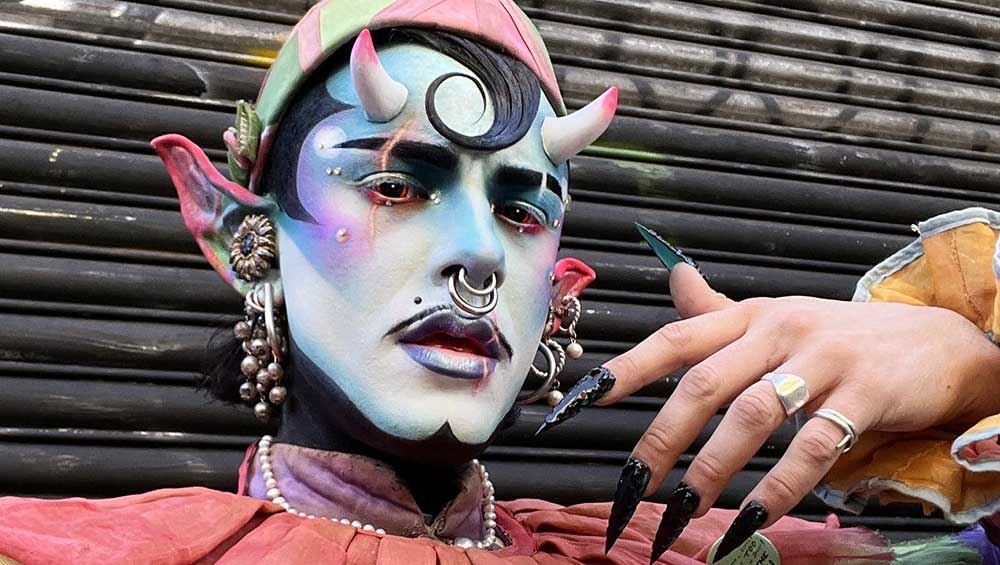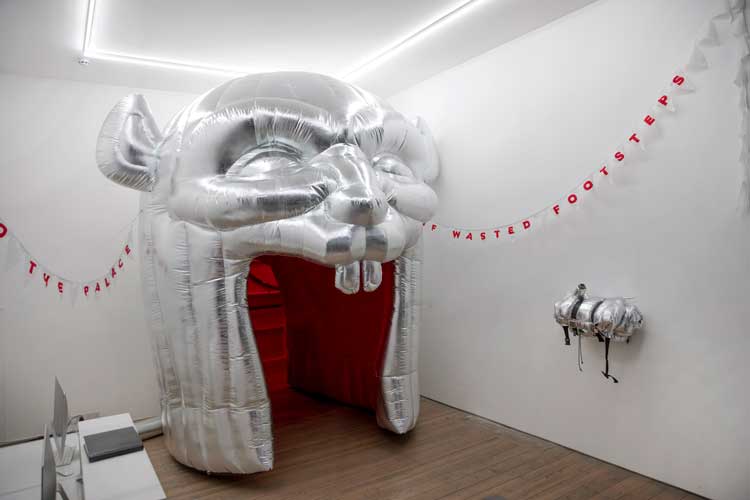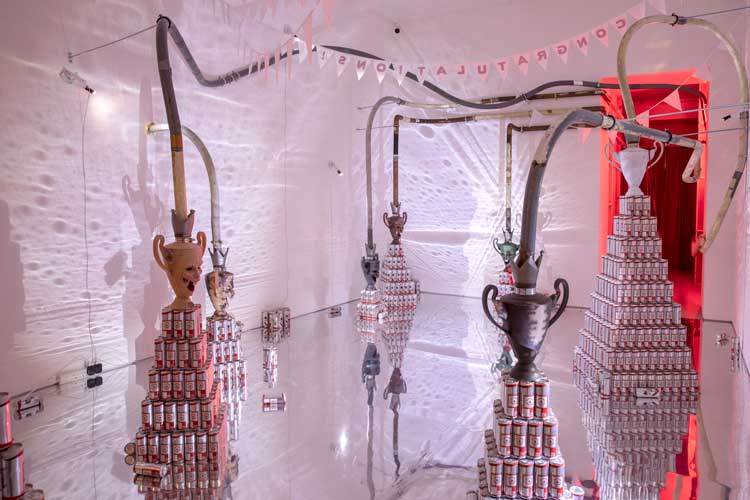
Portrait of Jenkin van Zyl. Photo courtesy the artist.
by JOE LLOYD
Musophobes beware. In his new film Surrender at Edel Assanti gallery, the London-based artist Jenkin van Zyl (b1993) takes us on a trip to a musty love hotel where eight humanoid rats compete in a series of bizarre, exhausting dances. We follow one rat-person, Grace, as she is drawn deeper and deeper into a state between enervation and euphoria, supervised by masked nurses and judges. Instructions are received by pneumatic tube. There is a mock wedding, “tail whispering” and “long-distance lactating”. In between, they have moments of rest, albeit in bedrooms with televisions that refuse to turn off.

Jenkin van Zyl, Surrender. Installation view, Edel Assanti, London, 2023. Copyright Jenkin van Zyl, courtesy Edel Assanti, London.
Van Zyl was in part inspired by dance marathons – mammoth endurance events popular in the 1920s and 30s – and Surrender captures their combination of joy and pain, freedom and claustrophobia. The work extends beyond the film. Van Zyl has transformed Edel Assanti into a series of spaces that reconstruct and rearrange elements found in Surrender. You enter through a giant silvery rat’s head, an echo of the hellmouths found on the Renaissance stage. After traversing a corridor of tubes, you enter a bedroom, where you can view the film while lying down. Finally, a room of sculptural trophies awaits, sinister rat heads mounted on stacks of energy drinks.

Jenkin van Zyl, Surrender. Installation view, Edel Assanti, London, 2023. Copyright Jenkin van Zyl, courtesy Edel Assanti, London.
Van Zyl graduated with an MA from the Royal Academy Schools in 2021 and has already created a distinctive visual world. His films take place in forlorn, abandoned locations. They feature masked actors performing ritualised acts, interacting with eerie settings and surreal props. Looners (2019) starred masked humanoids participating in acts of violence and pleasure in the ruins of an abandoned Hollywood film set. Machines of Love (2020-1), which premiered at Glasgow International, saw ghoulish figures play grisly games in the frosty landscape of Iceland. There is reference to queer nightlife and the erotic avenues it can lead down, but also horror and fantasy films, folklore, history trends and defunct machinery. Surrender is Van Zyl’s most concentrated opus yet.
Studio International caught up with Van Zyl at Eden Assanti, ahead of the exhibition’s opening.
JOE LLOYD: We enter the experience through an enormous, rat-shaped maw, which also appears in the film, and then pass through a corridor filled with tubes.
JENKIN VAN ZYL: I’ve long been fascinated by hellmouths. And one of the key research points are short-stay love hotels in Japan, where a doorway often serves as a kind of portal to bliss and fantasy. So, I imagine this as an entrance to the work.
For years I’ve been trying to get hold of a Lamson pneumatic tube system. This is the last remaining one in the UK – and it was installed in Reading in a department store called Jacksons. When it was removed, an archivist kept it and took care of it in a shed in the back of his garden. He died last year, and I got in touch with his fiancee, who liked the sound of the project and let me come to collect it. They were used as cash carry systems in shops, and to transport medical vials and samples in hospitals. But I was more interested in their use in certain love hotels as a device to facilitate anonymity. If you enter these love hotels, you are made to push buttons and you don’t see any staff. Everything from selecting your room to paying and getting receipts, to ordering toothbrushes or dildos is run via these canisters. It’s a means of discretion and mediation. I found that fascinating. Here, it is used as the central nervous system of the rats, as a telegram or messaging device.

Jenkin van Zyl, Surrender. Installation view, Edel Assanti, London, 2023. Copyright Jenkin van Zyl, courtesy Edel Assanti, London.
JL: Surrender begins and ends with a reference to the rat king, and the tangled tubes seem to work as a parole.
JVZ: Yes, another thing that I was thinking about with the tube system is the lore of the rat king. Which is this idea – we don’t know whether it’s true – that a burrow of rats, grappling their tails together to stay warm, will form this knotted mass through a combination of piss and shit and dirt and other excretions. They may have been some sort of sideshow cryptid thing. But I like them as this repeated symbolic and metaphorical device throughout the film, both as a choreographing device and as a means to explore this forming of self, other and community. And this complicated braiding that repeats in the film. The pneumatic tube system becomes this rat king that holds the film together.
JL: Do you conceive the film, sculptures and installations as a single work of art?
JVZ: The rooms are about encountering things that then get reformulated when you see the film. One of the exciting things about working in art spaces and not conventional cinema is that you can build these sculptural elements. My aim with that is not to replicate the film directly or create a sort of exported set, but rather to have this sort of funhouse mirror version of what's happening in the film. Things get remixed or flipped or distorted. I think that's important. Also, I hate uncomfortable gallery seating. For me, this is a good chance to have some comfortable seating.

Jenkin van Zyl: Surrender. Film still. Courtesy the artist.
JL: The film shows a set of rat-people endure a series of exhausting dance tasks in a crumbling, isolated ballroom. What drew you to dance marathons?
JVZ: Dance marathons are a thing that I've tried to incorporate into films in the last few years, and this is the one that has the most direct relationship to it. These dance marathons were these pageants of fatigue in the 1920s and 30s that would have this almost non-stop dancing, with couples competing in increasingly desperate circumstances as the 20s rolled into the Depression. I was interested in the spectacle of exhaustion, and the commodification of that idea of suffering in public.
I'm also very interested in the dancers. There are amazing photographs of couples collapsing in these beautiful, lyrical curls. The idea is that as the months would roll on the dancers would become so exhausted that it was essentially like a shuffle. One of the dancers would have to remain in a state of motion to stay in the marathon and there are amazing photos of dancers being dragged along the floor by their partners.

Jenkin van Zyl: Surrender. Film still. Courtesy the artist.
JL: Wow! Were they allowed breaks?
JVZ: Organisers would manipulate the competition like reality TV. But competitors would have, for example, 15-minute naps. For some, there would be these cots upstairs that people would sleep in. They would learn how to multitask: how to sleep while moving, and shave while dancing. I was interested in that combination of spectacle and suffering. That became a key thing, along with the rat king and these love hotels, and my interest in historical re-enactment. It became this strange melting pot. In the film, it's unclear whether the lead character, Grace, checks into a dance marathon or a re-enactment experience or a fantastical retreat, and it constantly shifts between those prompts, and I think she doesn't know herself.
JL: The marathons remind me of the Strasbourg dancing plague, or depictions of the dance of death.
JVZ: It does link to medieval times: they are those amazing drawings of circles of bodies and clusters of bodies that, for me, also became an interesting link to the rat king, these circulated bodies that are all knotted together. I'm really interested in the yearning for meaning, in this backdrop of deadlock and despair that we're in now. Not so much attaining meaning, but this sense of constant yearning and desire. And this sort of propulsion leads the character back to the beginning and the film exists as an eternal loop. So, there's a strange purgatorial space.

Jenkin van Zyl: Surrender. Film still. Courtesy the artist.
JL: Watching the film, I certainly felt that Grace and the dancers were trapped in a sort of eternal otherworld, living the same events over and over again.
JVZ: I'm interested in capturing these sites of purgatory and paradise that circulate into one another. I guess that's because I'm always interested in the collapse of binary positions: in this film, self and other, front- and backstage, violence and pleasure. That's something that I am always keen to do. If there are currents of violence, they are counterbalanced by moments of tenderness or kindness. I think that comes down to trying to unpack complicated spaces, such as the dance floor in this film. I suppose the dance floor in the film is a proxy for the queer night club, the labyrinth, the belly of the whale, the treadmill, the hamster wheel, all these different things. It's like looking at that space as a mutative space for unpacking some of the complexities of contemporary – or, I hope, contemporary – politics of desire.
I've been sensing that there's this dreadful feeling of living in decades of declining living standards and this sense of overlapping emergencies, and the constant crisis, which is compounded by this access to information. It's a very confusing, overwhelming moment. Within that, I'm interested in creating these sets of characters or communities that exist either by necessity or design, that have to reformulate the world around them. I think that's an undercurrent in the film: this sense of self in the presence of this overwhelming vortex.
The world has ended many times over, and we're not living in a unique – well, we probably do live in a unique one because of the impending climate disaster – but the world has ended so many times before. That’s something else that I'm interested in: the idea of loops or recursive returns, the idea that characters exist in their ability to reform and recoup after both exhaustion in the film and also forms of ego-death or oblivion. There's always this idea of reconstitution.
JL: The lead character in Surrender is called Grace. How did you name your rat-people?
JVZ: Grace and Faith were symbolic names, and the other two – I wrote the films in good part with my friend [author and performer] Brittany Newell, and the other two names were an inside joke. She tattooed the name Jennifer on my arse once, so that had to go in. But Grace is a symbolic name, and there are moments where it gets used as text, like when she draws it with smoke on the ceiling.
JL: The film has a very coherent sense of place, but also feels out of time, as if it could be anywhere from the 1930s to a dystopian future. Tell me about the set.
JVZ: We built the hotel room in my studio. I have a studio in Woolwich [in south-east London] in an abandoned office building, so it has lots of slightly dishevelled abandoned rooms in it. The ballroom scenes are shot in the Mildmay Club, a members’ club in Newington Green [north London]. During the era of extreme enduring events, it used to host endurance flagpole sitting and other bizarre events – close enough to the dance marathons. The decor has been updated at weird times and at different places. I'm interested in anachronisms and strange conflicting things, such as having mobile phones with ballroom music, so you are not sure when it is set within the 20th and 21st centuries.
I imagined that these hotel rooms formed a panopticon around the ballroom floor, and there would be this loop of film from drones and security cameras showing the dancing that would be fed back into the hotel room TVs. If that was this square hotel, I imagined that the tubes form the nervous system within that and would lead to this huge pneumatic tube that led to the rat mouth. That was filmed within a jet engine testing facility, where they have this big tunnel that they would blow fire up. And that gets used as an entrance and exit point of the hotel.

Jenkin van Zyl: Surrender. Film still. Courtesy the artist.
JL: Surrender is shot almost entirely in interior spaces, many of them small. It felt almost claustrophobic. Whereas some of your previous works – Machines of Love, for instance – have a more expansive outdoor setting.
JVZ: The last bit of Machines of Love was shot in Iceland. It was on that weekend where Covid caught up with the UK. We arrived and we saw people wearing masks and we thought: “What's going on?” We had a really bad signal as we were driving across this snow-ridden landscape, and each time we got access to the radio, things had got so much worse. We got a call from GI [Glasgow International] the moment before we were about to shoot saying the festival had been cancelled. That project was shot in a really short amount of time. What I really enjoyed about this was the ability to be able to work on location in the UK, both in pre- and post-production, so I was excited for this one.
JL: Do you envisage yourself as a film director?
JVZ: Yes, I guess so. I came into the film-making bit by accident. I was making installations at art school that were supposed to house imaginary films. The logical next step was to make films. Although I did make a lot of films when I was about 11, sort of Almodóvar-style soap operas in the living room. I think there’s a thing in the art world of wanting to place artists as social workers, so they are embedded in active community things and serve the function that the government doesn't. I always think this is in place of putting money into those communities, so I'm always a bit sceptical about that. Or they're posited as lone geniuses. And I think what's really nice about film-making is that it's very collaborative, and you're neither of those things.
In terms of what I work on, I do a lot of the stuff. I do too much stuff – I really want to have the money to work with other people but, because of necessity, I do all the costumes, the camera, the editing work, the sound. But that's all under direction, in a way.

Jenkin van Zyl: Surrender. Film still. Courtesy the artist.
JL: One consistency in all your films is the use of masks and prosthetics. What drove you to these? They give Surrender the veneer of a horror film.
JVZ: The ones that were in Machines of Love were more horrific. That film, in particular, I was doing quite a lot of guerrilla-style film-making in semi-abandoned Hollywood film sets. The first one I made for my BA, which was in the spaghetti western sets in Spain. They're all in such bad condition, crumbling. And it's interesting, because some of the extras who were working on a Clint Eastwood film there bought the land. So, it's owned by the children of extras, which I think is really interesting. But that was the first proper film I made. We were staying in a cabin nearby, and at night we would wander through the desert to film stuff, and then get caught by the guard dog and run out, and then go back when the coast was clear. It was all shot on GoPros and with torches.
From then on, I became more interested in using the detritus of film-making and productions, sourcing bits of film sets and theatre productions, and reconfiguring the ruins of Hollywood epics. The masks that we used in Machines of Love and the sets were both things that had never been used. The masks were made for a fantasy film in Australia and the sets were built and left to decay. I was interested in these strange, floating unused props that would be breathed into life through production.
The film prior to that, Looners, had more humanoid masks. Some of them are in this one, playing the hotel staff. They are made by American SFX companies and they've been used for bank robberies and for mask fetishists, who will wear them to go to the shops and get a thrill through passing as anonymous in public. So, there's a sexual thrill from it. And also for weird cosplayers. So, they're kind of used by different, marginal communities. They're often modelled on this masculinist idea of video-game characters, so they have strange, action doll-like figures.
They're also a nightmare because they're so uncomfortable. In Surrender, the rat masks have no breathing space! The hardest part of filming was taking care of eight cast members when you couldn’t read their facial expressions. The silver suits were sleeping bags from a company that makes survival gear for extreme weather conditions. We were shooting in July, with the cast wearing these full body sweatsuits. We had to take a break every 10 minutes.
• Jenkin van Zyl: Surrender is at Edel Assanti, London, until 4 March 2023.